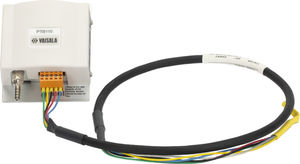
- Components - Spare Parts
- Electricity and Wiring
- Pressure sensor for the aerospace industry
- CAMPBELL SCIENTIFIC LTD.
Pressure sensor for the aerospace industry CS100 barometricanalog outputfor aircraft
Add to favorites
Compare this product
fo_shop_gate_exact_title
Characteristics
- Domain
- for the aerospace industry
- Pressure type
- barometric
- Output signal
- analog output
- Applications
- for aircraft
- Pressure range
Min.: 600 mbar
(8.7 psi)Max.: 1,100 mbar
(15.95 psi)- Temperature range
Min.: -40 °C
(-40 °F)Max.: 60 °C
(140 °F)
Description
Overview
The CS100 measures barometric pressure for the range of 600 to 1100 mb. This range equates to from below sea level (as in a mine) up to 12,000 feet above sea level. Designed for use in environmental applications, the CS100 is compatible with all Campbell Scientific dataloggers.
Benefits and Features
Optimized to mount in Campbell Scientific enclosures
Low power consumption
Three-year warranty
500 to 1100 hPa (mBar) and 800 to 1100 hPa (mBar) versions also available by special order—contact Campbell Scientific
Integral switching circuit limits power consumption to measurement cycle
Technical Description
The CS100 is a Campbell Scientific version of Setra's model 278 barometer. It uses Setra’s Setraceram capacitive sensor and IC analog circuit to measure barometric pressure.
The CS100 is encased in a stainless steel and polyester case fitted with an 1/8 in. barbed fitting for pressure connection. It includes an internal switching circuit that allows the datalogger to power the barometer only during measurement, which reduces power consumption.
Specifications
Measurement Description - Barometric pressure
Signal Type/Output - Analog voltage
-NOTE- - 1 hPa = 1 mBar
Pressure Range - 600 to 1100 hPa
Long-Term Stability - ±0.1 hPa per year
Response Time - < 100 ms
Resolution - ±0.01 hPa
Excitation - 9.5 to 28 Vdc
Catalogs
CS100
2 Pages
Other CAMPBELL SCIENTIFIC LTD. products
Barometric Pressure Sensors
*Prices are pre-tax. They exclude delivery charges and customs duties and do not include additional charges for installation or activation options. Prices are indicative only and may vary by country, with changes to the cost of raw materials and exchange rates.



